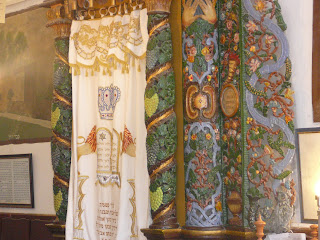We finally made it over to the park the morning of Friday, August 19 and, in spite of being disoriented geographically within the park, were not disappointed.
We went over to the east end of HaYarkon, hoping to be away from the boat/kayak rentals, amusement park, etc. It was busy with bicyclers and a few families, but not enough to be disruptive.

The river itself didn’t appear to have many birds in it.

We meant to go to an inland pond, but were never able to find it. However, we followed a few of the trails, both paved and dirt, to see what we could see.
Advice to future birders at HaYarkon: always take the high trails. The low ones, meant for bicycling, take you through thick vegetation with little viewing of the water. The paved trails, at least for us, yielded many more birds.
Our first sightings weren’t birds at all, but a couple of lizards. We hadn’t seen but one during our time outside Tel Aviv, so we were excited when two turned up in rapid succession.


With no new birds for the day, we were able to use our learning curve and were pleased we were able to identify every bird we saw without using our field guide.
The first was Spur-winged Lapwing (both an adult and a juvenile). We photographed the adult, a handsomely marked bird.

Common Myna was, well, common throughout the park. These are not native, but introduced (along with Rose-ringed Parakeets). Apparently, the first tree nesting pair of these used date palms in HaYarkon Park. (Holzapfel, Levin, Hatzofe, & Kark)

We were delighted when, toward the end of our walk, we came across a large (maybe a dozen) flock of European Bee Eaters. Some were hawking insects, others were perched together in a tall tree. We couldn’t get a great photo, but managed to get one that shows identifying marks.

All in all, we spent about two hours walking and birding. At that point, the heat of the day got to be a bit much, so we gave up.
May I encourage others to visit this urban oasis. I’m sure we would have come across many more birds had we gone earlier or at a cooler time of the year.
THE LIST:
Cattle Egret
Glossy Ibis
Mallard
Spur-winged Lapwing
Rock Pigeon
Laughing Dove
Common Kingfisher
Pied Kingfisher
European Bee Eater
Rose-ringed Parakeet
Syrian Woodpecker
Barn Swallow
White-spectacled Bulbul
Graceful Prinia
Palestine Sunbird
Eurasian Jay
Eurasian Jackdaw
Hooded Crow
Common Myna
House Sparrow

































































